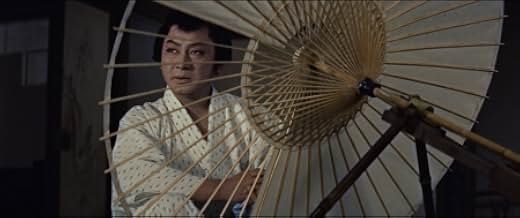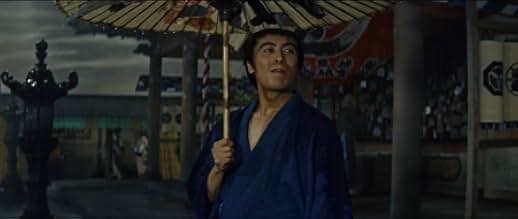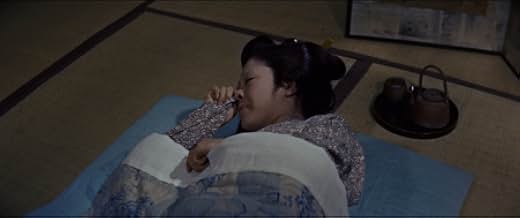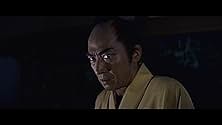NOTE IMDb
7,0/10
2 k
MA NOTE
Ajouter une intrigue dans votre langueThe ghost of a samurai's wife takes revenge on her husband.The ghost of a samurai's wife takes revenge on her husband.The ghost of a samurai's wife takes revenge on her husband.
- Réalisation
- Scénario
- Casting principal
Katsuko Wakasugi
- Iwa
- (as Kazuko Wakasugi)
Haruhiko Nakagawa
- Yomoshichi Satô
- (as Ryûzaburô Nakamura)
Avis à la une
Fast summery of the movie, it's about a samurai who wants a woman as his wife, Doea the unthinkable and then does it again.
It's a good plot and great acting in it. And the scenes are very good! Specially the final part and the scenes and how it's filmed are really nice. The last part of this movie really made the movie shine and it was really good stuff.
It's a good revenge movie, the main villians you really hope to die as mercyless and themselves were. I liked this movie a lot, even though I was sitting after half the movie wondering were the ghost stuff were suppose to happen and man didn't i have to wait long.
All in all, great horror movie.
It's a good plot and great acting in it. And the scenes are very good! Specially the final part and the scenes and how it's filmed are really nice. The last part of this movie really made the movie shine and it was really good stuff.
It's a good revenge movie, the main villians you really hope to die as mercyless and themselves were. I liked this movie a lot, even though I was sitting after half the movie wondering were the ghost stuff were suppose to happen and man didn't i have to wait long.
All in all, great horror movie.
This film essentially begins with a young samurai by the name of "Iemon Tamiya" (Shigeru Amachi) asking a more high-level samurai named "Samon Yotsuya" (Shinjiro Asano) to marry his daughter "Iwa Yotsuya). In response, Samon angrily refuses because he considers Iemon to be much too hedonistic and of low-moral character. Not surprisingly, this infuriates Iemon and, as if to prove Samon's point-he furiously draws his sword and kills the older man on the spot. Having witnessed the murder and wanting to capitalize on it, a cunning peasant named "Naosuke" (Shuntaro Emi) appears from the shadows and advises Iemon on exactly what to do next. Needless to say, Iemon listens quite intensely and in relatively little time he does, in fact, marry Iwa. Likewise, Naosuke also gets closer to realizing his ambition of marrying Iwa's sister "Sode" (Noriko Kitazawa) who was always out of reach for him due to his low status in life. However, what neither Iemon or Naosuke realize is that, eventually, their evil deeds will catch up to them--and when they do--they come in a most bizarre manner. Now, rather than reveal any more, I will just say that this was a good horror film which took a bit of time laying down the foundation of the story before really increasing in intensity later on. Admittedly, the costumes and makeup used pale in comparison to the CGI and special effects found in more modern films of today. No question about it. But even so, I thought that the overall movie was still quite entertaining, and I have rated it accordingly.
Shigeru Amachi wants to marry Katsuko Wakasugi, the daughter of prominent samurai Shinjirô Asano. Asano refuses the request, belittling Amachi who promptly murders him. Shuntarô Emi witnesses the murder and promises to help him cover it up, if he in turn helps him marry Wakasugi's sister. The two tell Wakasugi that her father was murdered by a notorious criminal and they will help her get revenge. Instead, they murder her sister's fiancé and Emi runs off with her.
Months later, Amachi and Wakasugi are married and living in Edo. Amachi has fallen for Junko Ikeuchi, the daughter of a nobleman, and hatches a plan to rid himself of Wakasugi. He hires Jun Ôtomo to seduce her so that he can legally kill her, but the plan goes awry. Ôtomo ends up dead and Wakasugi is poisoned causing hideous facial deformities before she also dies. Amachi marries Ikeuchi, but the spirits of Wakasugi and Ôtomo haunt him leading him to ruin.
This is probaby the best known adaptation of the kabuki play "Yotsuya Kaidan" (there are many). It's a fairly routine film from a story and characters perspective, but the film's vibrant colours and gory, hallucinatory visuals are really something.
Months later, Amachi and Wakasugi are married and living in Edo. Amachi has fallen for Junko Ikeuchi, the daughter of a nobleman, and hatches a plan to rid himself of Wakasugi. He hires Jun Ôtomo to seduce her so that he can legally kill her, but the plan goes awry. Ôtomo ends up dead and Wakasugi is poisoned causing hideous facial deformities before she also dies. Amachi marries Ikeuchi, but the spirits of Wakasugi and Ôtomo haunt him leading him to ruin.
This is probaby the best known adaptation of the kabuki play "Yotsuya Kaidan" (there are many). It's a fairly routine film from a story and characters perspective, but the film's vibrant colours and gory, hallucinatory visuals are really something.
Great film -- very compelling, entertaining and thought provoking.
My wonderful girlfriend somewhat randomly picked this up from at the video rental -- excellent film, very interesting story and very well presented. Really liked the character development and camera work -- angles were great and simple film editing (1959) created some excellent special effects.
A classic ghost story with a very clear moral message -- if you double deal on your wife, she will get ugly on you.
My wonderful girlfriend somewhat randomly picked this up from at the video rental -- excellent film, very interesting story and very well presented. Really liked the character development and camera work -- angles were great and simple film editing (1959) created some excellent special effects.
A classic ghost story with a very clear moral message -- if you double deal on your wife, she will get ugly on you.
Funny how things change. In 1949 Shintoho was producing prestige films like Akira Kurosawa's STRAY DOG. Ten years later they were producing scores of everything from lurid melodramas to nationalist war movies to cheap gangster flicks to kaidan period horror movies like this. Two years later, in 1961, they declared bankruptcy and closed shop, the first semi-big studio in postwar Japan to do so. Nobuo Nakagawa, along with Teruo Ishii who graduated from the film noir of the Chitai series into full blown sleaze and torture 10 years later, was one of those prolific studio filmmakers responsible for many of their kaidan pictures. His biggest call to fame is JIGOKU from the following year but this is an ample showcase of both the good and the bad of Shintoho film-making.
Based on the classic story by Nanboku Tsuruya about a conniving lowly samurai who is haunted by the ghost of the wife he murdered, a lot of the drama is hackneyed, the characters simple caricatures of good and evil, innocent and scheming, the dialogues delivered on-the-nose. Iemon, the murderous samurai, is played and depicted as the worst villain possible. No grey areas here, nothing morally ambiguous, the movie is melodrama played to the back of the house. And yet, the first appearance of the ghost sent chills down my spine. Ringu and Ju On didn't invent the pale-faced ghost that creeps along the edge of the frame. It was there 50 years ago and in Kabuki theater before that.
With the eye of a stylist, Nakagawa orchestrates a vision of hell on earth, ghosts rising from the ground or peering down from the ceiling, and it's all very stagey and theatrical probably to appeal to an audience already familiar with the story from Kabuki theater and as much creepy/atmospheric as it is graphic, certainly more graphic than American horror would dare to be for the next 10 years (we have blood gushing from wounds, facial deformities, and even an amputated limb), and while the whole is never as good as the parts, those parts should appeal to the horror fan who likes his lighting bright red and torquoise and his ghosts slow-moving and disfigured.
Based on the classic story by Nanboku Tsuruya about a conniving lowly samurai who is haunted by the ghost of the wife he murdered, a lot of the drama is hackneyed, the characters simple caricatures of good and evil, innocent and scheming, the dialogues delivered on-the-nose. Iemon, the murderous samurai, is played and depicted as the worst villain possible. No grey areas here, nothing morally ambiguous, the movie is melodrama played to the back of the house. And yet, the first appearance of the ghost sent chills down my spine. Ringu and Ju On didn't invent the pale-faced ghost that creeps along the edge of the frame. It was there 50 years ago and in Kabuki theater before that.
With the eye of a stylist, Nakagawa orchestrates a vision of hell on earth, ghosts rising from the ground or peering down from the ceiling, and it's all very stagey and theatrical probably to appeal to an audience already familiar with the story from Kabuki theater and as much creepy/atmospheric as it is graphic, certainly more graphic than American horror would dare to be for the next 10 years (we have blood gushing from wounds, facial deformities, and even an amputated limb), and while the whole is never as good as the parts, those parts should appeal to the horror fan who likes his lighting bright red and torquoise and his ghosts slow-moving and disfigured.
Le saviez-vous
- ConnexionsFeatured in Building the Inferno: Nobuo Nakagawa and the Making of 'Jigoku' (2006)
Meilleurs choix
Connectez-vous pour évaluer et suivre la liste de favoris afin de recevoir des recommandations personnalisées
- How long is The Ghost of Yotsuya?Alimenté par Alexa
Détails
- Durée1 heure 16 minutes
- Rapport de forme
- 2.35 : 1
Contribuer à cette page
Suggérer une modification ou ajouter du contenu manquant

Lacune principale
By what name was Histoire de fantômes japonais (1959) officially released in India in English?
Répondre

















